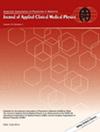Effects of cardiac motion on dose distribution during stereotactic arrhythmia radioablation treatment: A simulation and phantom study
Abstract
Purpose
Cardiac motion may degrade dose distribution during stereotactic arrhythmia radioablation using the CyberKnife system, a robotic radiosurgery system. This study evaluated the dose distribution changes using a self-made cardiac dynamic platform that mimics cardiac motion.
Methods
The cardiac dynamic platform was operated with amplitudes of 5 and 3.5 mm along the superior–inferior (SI) and left–right (LR) directions, respectively. The respiratory motion tracking of the CyberKnife system was applied when respiratory motion, simulated using a commercial platform, was introduced. The accuracy of respiratory motion tracking was evaluated by the correlation error between infrared markers and a fiducial marker. The dose distribution was compared with and without cardiac motion. The evaluations included error in the centroid analysis of the irradiated dose distribution, dose profile analysis in the SI and LR directions, and dose distribution analysis comparing the irradiated and planned dose distributions.
Results
Cardiac motion increased the correlation error in the direction of motion. Cardiac motion displaced the centroid by up to 0.23 and 0.19 mm in the SI and LR directions, respectively. Cardiac motion blurring caused the distance of the isodose lines to become smaller (bigger) at higher (lower) doses in the SI direction. The gamma pass rate was reduced by cardiac motion but exceeded 94.1% with 1 mm/3% for all conditions. Respiratory motion tracking was also effective under cardiac motion. The cardiac motion slightly varied the dose at the edges of the irradiation volume.
Conclusion
While cardiac motion increased respiratory tracking correlation errors, its effects on dose distribution were limited in this study. Further studies using motion phantoms that are close to a human or individual patient are necessary for a more detailed understanding of the effects of cardiac motion.


 求助内容:
求助内容: 应助结果提醒方式:
应助结果提醒方式:


